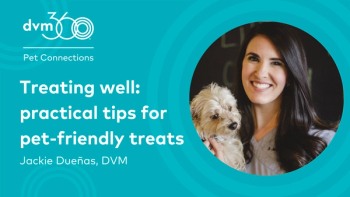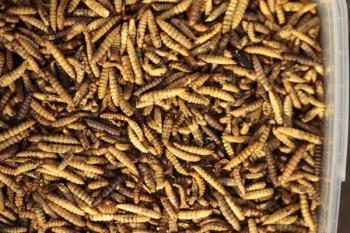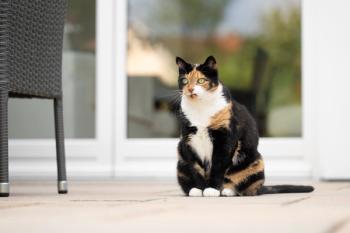
Important dietary and lifestyle factors in obese and sick patients
A Q&A with veterinary nutritionist C.A. Tony Buffington
DVM: What role does proper nutrition play in weight loss for animals?
Buffington: For every complex problem, there's a simple answer, and it's usually wrong. Keep in mind that because I practice at a university, I may have a different approach to nutrition than many primary-care practitioners. At the university level, we're not the first veterinarians that animals see. Usually, we are the second or third.
For each animal, I start by determining its daily food intake, how active it is and its level of stress, as well as the extent to which the patient's problem of obesity is influenced by each of these factors. I try to identify which factor is the most important in each particular case and begin there. Sometimes the animal is eating too much. You don't want to cut an animal's intake overnight, however. If you don't believe me, try telling someone to cut his or her access to food by 25 percent or 50 percent and notice what happens.
In the practice I work in, my perception is that animals are eating satisfactory diets. If they are quite overweight and upon interviewing the clients I learn that the animals are not eating very much, then sometimes we will change the diet to something higher in protein and lower in fat to try to change the balance of nutrients. There is some (not strong) evidence that the increase in protein and decrease in fat intake might alter metabolism in a helpful way. But to date, it has not been well-studied in naturally occurring obesity in dogs or cats.
DVM: How do you determine whether an animal is losing weight in a healthy manner?
Buffington: I like to see animals lose about 1 percent of body weight per week on average. Some weeks they may not lose any weight. Some weeks they may lose more. We shoot for 1 percent loss of current weight per week as a goal.
DVM: How important is a strict diet for a pet in terms of weight loss?
Buffington: This depends on how big a role diet is playing. In fact, the focus should be on "obesity therapy" rather than strictly on "weight loss." This is because we need to be more concerned with maintenance of the lost weight than with the weight loss.
I think an important goal is to find ways for clients to express love for their pets other than with food. If an animal's life is chaotic, we will explore finding routines that create a sense of control for the animal, as well as enrich the environment in which it lives.
DVM: Does the new diet need to be continued for the lifetime of the animal?
Buffington: No. One of the reasons we don't do a great job of treating obesity is that we only look at diet. A better question would be, "Does obesity therapy need to be continued for the lifetime of the animal?" The answer to this question is yes. Obesity is a chronic, recurring, relapsing medical condition that requires lifetime therapy.
DVM: What are some misconceptions surrounding weight loss and obesity therapy in pets?
Buffington: A common misconception is that to treat obesity, all you have to do is cut food intake — it's easy. If it were that easy, we wouldn't have a problem.
And one of the biggest myths regarding obesity therapy is that you can calculate the number of calories an animal needs. The only way to know appropriate calories for an individual patient is to use body condition score.
DVM: How is weight loss addressed by veterinarians today vs. 10, 20 or 30 years ago?
Buffington: Obesity is more common now than years ago. Veterinarians are starting to look more broadly at obesity therapy, addressing the whole problem, including increasing activity for owners and pets. Obesity is now recognized as a more complicated problem, with many more contributing factors than once thought. The focus today is on individualizing care for the patient. We appreciate that every obese patient may not have the same cause or require the same treatment.
DVM: Has client compliance in these cases improved in the last decade?
Buffington: Client compliance really depends on excellent communication between the veterinarian and the pet's caregiver. Veterinarians' appreciation, interest and use of effective communication techniques have increased dramatically in the last 10 years.
DVM: What are some specific ways a veterinarian can improve client compliance?
Buffington: Listen to your clients, and work with them to shape solutions that work for their particular situations. Share responsibility for the outcome with clients. For example, ask owners, "What do you think is the best approach for controlling your pet's weight?" Clients can often offer the best solutions based on what goes on in their houses. A veterinarian cannot get this valuable information without asking.
What I tell clients is, "Here's my understanding of the situation." I'll proceed to feed back to them what I heard them tell me. Then I'll ask, "Have I got this right?" If so, I'll tell them, "In my experience, clients who have had similar situations have tried these solutions. I don't know what will work best for you — maybe one of these will work, maybe none will. These may get you thinking about what will work best for your situation." I then give clients a chance to select a strategy or come up with some ideas of their own.
This approach exemplifies the difference between compliance and adherence. Compliance is something you do because "I say so." For adherence, you do it because you want to, and because you understand the value. Because people can sustain adherence longer than compliance, I always try to craft a plan based on what is in the client's best interest. This doesn't work for all scenarios, however. For instance, for the rabies vaccine, you don't want to have a conversation about what to do. Clients have to do this — it's the law.
With adherence, it boils down to the notion that you want clients to do something because they can, and because it will help them if they do.
DVM: Has the thinking on client compliance and communication by the veterinary community evolved over time?
Buffington: I'm afraid that some veterinarians still expect people will do things because they tell them to. With our clients, to get them to act, we have to convince them that it's in their best interest.
I'm a big fan of praising owners and telling them they're being great pet owners just for seeking care. I tell them my recommendations for obesity therapy are only a guess based on my clinical experience. I can tell the client to try to feed a particular diet. If an animal's body condition changes in the direction we want, then we guessed well. If it doesn't change, we guessed wrong, and we will try something else until we succeed together.
DVM:What are some focal points of sick-animal nutrition?
Buffington: This is such a broad topic — it depends on what role nutrition is playing. There's the Circle of Nutrition illustration put forth by the American College of Veterinary Nutrition. It depicts an animal with an arrow connecting to diet and another arrow connecting to an owner's hands. For sick animals, you want to determine where the problem is. Is it in the animal, diet, relationship between client and owner? Focus on the source of the problem. Recognize that any time we alter one part of that circle, everything else may change, so we have to continually reevaluate our decisions based on outcomes.
DVM:Switching gears, what are the most important ways to handle a sick animal's nutritional needs?
Buffington: If someone wants to introduce a therapeutic diet, it never should be introduced in the hospital. If an animal associates a particular diet with being sick, the animal may never eat it again. The animal should be offered its favorite foods when in the hospital. Then, when the animal gets home and is feeling better, that's when you can try to introduce a new diet. You introduce it in the comfort and safety of the patient's own home during recovery to increase the chances of acceptance.
DVM:Are there any must-follow requirements with regard to sick-animal nutrition?
Buffington: Find out the favorite foods of the animal. If an animal stops eating, what I want to know is, will it not eat anything, or does it not like the therapeutic food but still likes its favorite foods? An important thing to sort out in a chronically ill patient is whether the animal has gotten fatigued on a therapeutic food or whether the disease may be progressing.
It might be that the patient doesn't want to eat the diet but is otherwise fine, in which case I think the patient may be "tired" of the diet. If the animal is not eating, shows no interest in its favorite foods and is moping around, then I want to see the animal to be sure the disease hasn't progressed.
DVM:Are there any other key concepts to consider with regard to sick-animal nutrition?
Buffington: Honestly, I don't think nutrition is magic. Nutrition is important and useful, but it is more important to me that the animal eat a little of a less-than-perfect diet than to eat none of a "perfect" diet.
I introduce diet therapy somewhat slower than some of my colleagues. We often see animals in late stages of disease. Frankly, diet doesn't have much to offer at this point, except quality of life between the owner and animal, so I try to maximize the quality of the time left in the relationship.
Editor's Note: C.A. Tony Buffington, DVM, MS, PhD, Dipl. ACVN, is a professor in the Department of Veterinary Clinical Sciences at The Ohio State University.
Ms. Skernivitz is a freelance writer in Cleveland, Ohio.
Newsletter
From exam room tips to practice management insights, get trusted veterinary news delivered straight to your inbox—subscribe to dvm360.






